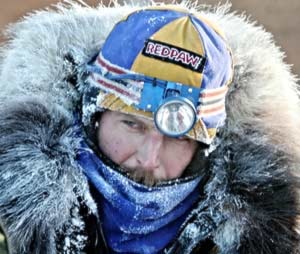DAWSON CITY
On the Quest trail several nights ago, Hans Gatt and William Kleedehn stayed in a ramshackle cabin.
“In a couple years it will be caved right in,” said Kleedehn.
“It reminded me of the Quest.”
In the ‘90s it was not uncommon for the Quest to see upwards of 35 teams starting the race.
Now, it struggles to lure more than 20.
“There are two major things you need for a dog race, other than dogs,” said dog driver Gerry Willomitzer. “You need a good trail and a good purse.”
This year’s Quest had neither, say several mushers.
To have a good trail, it’s just a matter of getting the volunteers out early enough, said Willomitzer.
“A trail can survive warm weather if you put it in early.”
But the race relies on volunteer trailbreakers, he said.
“You can’t push volunteers, and this year they were late putting in the trail.
“Although the trail from Dawson to Pelly Crossing was beautiful. The Canadian Rangers always do a good job.”
“The trail wasn’t very well-marked, especially on the Alaskan side,” said Dave Dalton, who placed fourth this year.
“It’s always the toughest trail in the world, but this year I don’t know what the heck to say about it — it made me think twice about coming back next year.”
The Quest needs a professional trail crew, because a trail makes or breaks a race, said Willomitzer.
“There needs to be money set aside to establish and maintain a trail, rather than spending money on other things.”
It was lucky those stranded mushers were flown off Eagle Summit, he added.
“Because, with those rookie mushers trying to get down that mountain with no markers and no snow, there could have been a major disaster.
“The Quest needs to spend less money on administration, flashy media events and follow-ups and focus more on the key elements of the race, which is the purse and the trail.”
The trail also affects how the dogs get through the race, said Willomitzer.
“And they shouldn’t have these major injuries if there was a proper trail.”
The trail was fine, said race marshal Mike McCowan.
“It’s a 1,000 mile race and there are a large variety of weather conditions — you can’t change the weather,” said McCowan.
In the past, teams have bumped over bare ground and, at other times, there has been eight feet of snow, he said.
So, what would force McCowan to cancel a race?
“I don’t know, a hurricane,” he said.
Canceling the race would be a huge blow to the mushers, he said.
“They have spent all this money getting ready for the race and they need this chance to replace it with prize money.”
Unfortunately, the Quest prize money isn’t much.
“I have raced in 300-mile races with bigger purses,” said Willomitzer.
The Quest winner gets $30,000. This year’s Iditarod will offer the winning musher over $70,000 and a new truck.
“It’s not about getting rich,” said Willomitzer. “But you don’t even make your money back, the average musher will have spent more than $30,000 preparing for the race.”
Something needs to be done about the purse, said race judge Thomas Tetz.
“You need money when racing to pay all the bills to race again later.”
The Quest’s purse has been the same since ’93, but the costs of putting on the race have continued to rise.
“So, how come there is more money for putting on the race, but not for the purse?” asked Willomitzer.
“Mushers come anyway, but not in as big numbers anymore.” However, when the purse keeps increasing, the number of mushers will keep increasing, he said.
